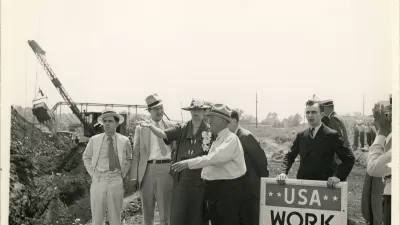The $787 billion American Recovery and Reinvestment Act that President Obama signed on Feb. 17 left advocates of compact and transit-oriented development practically biting their tongues.
On the whole, urbanists remain upbeat about what to expect from the Obama administration. "They've assembled a superb team at HUD," Yaro said, citing the appointment of New York City Housing Commissioner Shaun Donovan as secretary and King County (Washington) Executive Ron Sims as leader of a new Office of Sustainability within HUD. Sims pursued transit improvements in the Seattle region and shifted land-use planning toward less reliance on automobiles. As head of the Office of Sustainability, he will work with the US Departments of Energy and Transportation on making the nation more sustainable.
"There is a growing recognition that the way we build housing and our cities [is] in no way sustainable," Donovan said recently. Improving the energy efficiency of housing is important, but in addition, "we must focus on location efficiency," he asserted.
Bill Spikowski, a city planning consultant in Fort Myers, Florida, noted that the stimulus package's Energy Efficiency and Conservation Grants program, funded at $6.3 billion, includes a section premised on making cities more energy-efficient by promoting transit-oriented development, mixed uses, pedestrian-oriented design, and other strategies that reduce vehicle miles traveled.
More importantly, Obama himself has expressed a desire to alter the patterns of American development. "I think right now we don't do a lot of effective planning at the regional level when it comes to transportation," the president said Feb. 13 in an interview with five columnists. "That's hugely inefficient. Not only does it probably consume more money in terms of getting projects done, but it also ends up creating traffic patterns, for example, that are really hugely wasteful when it comes to energy use."
"If we can start building in more incentives for more effective planning at the local level, that's not just good transportation policy, it's good energy policy," Obama said. "So we'll be working with transportation committees to see if we can move in that direction."
Thanks to Renee Gayle
FULL STORY: Fed stimulus seen as 'down payment' on smart growth

Planetizen Federal Action Tracker
A weekly monitor of how Trump’s orders and actions are impacting planners and planning in America.

Map: Where Senate Republicans Want to Sell Your Public Lands
For public land advocates, the Senate Republicans’ proposal to sell millions of acres of public land in the West is “the biggest fight of their careers.”

Restaurant Patios Were a Pandemic Win — Why Were They so Hard to Keep?
Social distancing requirements and changes in travel patterns prompted cities to pilot new uses for street and sidewalk space. Then it got complicated.

Maui's Vacation Rental Debate Turns Ugly
Verbal attacks, misinformation campaigns and fistfights plague a high-stakes debate to convert thousands of vacation rentals into long-term housing.

San Francisco Suspends Traffic Calming Amidst Record Deaths
Citing “a challenging fiscal landscape,” the city will cease the program on the heels of 42 traffic deaths, including 24 pedestrians.

California Homeless Arrests, Citations Spike After Ruling
An investigation reveals that anti-homeless actions increased up to 500% after Grants Pass v. Johnson — even in cities claiming no policy change.
Urban Design for Planners 1: Software Tools
This six-course series explores essential urban design concepts using open source software and equips planners with the tools they need to participate fully in the urban design process.
Planning for Universal Design
Learn the tools for implementing Universal Design in planning regulations.
Heyer Gruel & Associates PA
JM Goldson LLC
Custer County Colorado
City of Camden Redevelopment Agency
City of Astoria
Transportation Research & Education Center (TREC) at Portland State University
Camden Redevelopment Agency
City of Claremont
Municipality of Princeton (NJ)





























